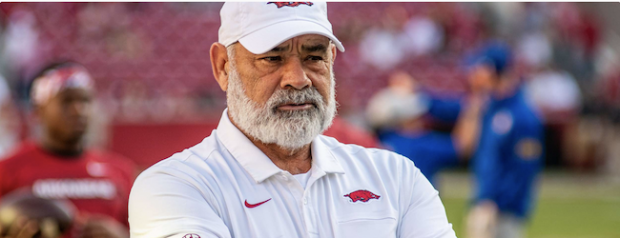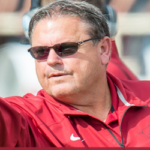
By Jim Harris
In 2011, the first time LSU-Alabama had a 1-2 “Game of the Century” for this 100-year period, John Chavis had a big part in it. As defensive coordinator for LSU, he fielded the best defense the Tigers had suited in ages, one good enough to match what Nick Saban as Alabama head coach was doing with his Crimson Tide, with future Georgia head coach Kirby Smart in tow as his coordinator. Sure enough, neither defense yielded at the goal line. They finished regulation time 6-6, and LSU won in overtime on the fifth made field goal of the game.
You’ll recall that while a lot of young folks used to touchdowns may have let out a collective yawn, the old heads saw it as a classic SEC “slobber-knocker” right out of the 1950s or ’60s.
Flash forward eight years, the same day “Chief” had seen his current charges at Arkansas yield five touchdowns on the first five possessions by Western Kentucky to fall behind 35-7 by halftime. “Chief” had long since confided with close friends that the talent level he had at Arkansas the past two years was the lowest he’d experienced in 42 years of college coaching. It didn’t help matters that a couple of the better, older players on his unit just quit on John Chavis and their head coach, Chad Morris. It doesn’t take much mental checkout on the roster to effect the whole team.
Meanwhile, a short time later that same day, LSU and Alabama met yet again in Tuscaloosa in another “Game of the Century.” This one was ended 46-41, again in LSU’s favor, and yet nobody decried the defensive play or any lack of physical play among the two teams. It wasn’t 7-on-7 or indoor-style football or any of that. Those defenses are great, last weekend’s 37 points surrendered by LSU to Ole Miss notwithstanding, and they’re still commanded by the current best defensive minds in the game – Dave Aranda as LSU’s coordinator; Saban still in charge at ‘Bama (quick quiz: name his coordinator).
The defensive talent is still the best around and concentrated again on those two teams, as it was in 2011.
It’s just that the game has changed drastically since that 2011 showdown.
Nick Saban saw it coming and finally found an offensive coordinator, Lane Kiffin, who would help the Crimson Tide adjust with the times starting in 2014. Steve Sarkisian, now calling plays for Saban, has made two stopovers at ’Bama. Meanwhile Les Miles, LSU’s head coach in 2011, lost his job with the Tigers in 2016 because, even though he annually claimed to Tiger fans that he would “open up the offense,” he never did. How many times did Miles’ run-first attack “play down” to the competition, especially against Arkansas, while HIS own NFL-type receivers (Odell Beckham, Jarvis Landry et al.) ran around the field and blocked, when they could have been catching beau coup passes.
LSU head coach Ed Orgeron, the one-time Arkansas assistant strength coach during the Ken Hatfield coaching era, comes across as old-school as they come, but obviously he’s been willing to change and not just talk the talk. First, when he’d had the interim tag removed after succeeding Miles in 2016, he tried Matt Canada as a coordinator, but they went together like oil and water. He turned things back over to old-head Steve Ensminger, Charlie McClendon’s last quarterback back in 1979, who in turn decided old school was, indeed, old school and welcomed Joe Brady from the New Orleans Saints to come aboard the coaching staff and install a real, NFL-type passing game to complement the talents of senior quarterback Joe Burrow.
It’s been pretty amazing at Baton Rouge, with Burrow now atop the favorites to take home only LSU’s second Heisman Trophy (Billy Cannon won the only other one for LSU, in 1959). LSU has looked like the best team in the nation since the opening night of this season, though Ohio State – also high-octane and letting its skilled players make plays – may have something to say about that.
And John Chavis? Most of the Razorback faithful who saw him hired by Chad Morris have long thought the game had passed him by. He may have been good for the old-fashioned SEC brawls of yesteryear that Tennessee played under Philip Fulmer, before Fulmer was ousted in 2008. After that 2011 LSU team lost the rematch in the national title game to Alabama 21-0 in the Sugar Bowl, Chavis was already feeling overburdened having to be leaned on so heavily by Miles, while all those offensive weapons were kept in the slow lane. When Chavis deduced that Miles was on thin ice in 2015 with the Tiger faithful and assistants contract were being rewritten so the school, already bleeding red ink, didn’t have to pay large buyouts to everyone, he left for Texas A&M.
There, it’s said by the Chavis supporters, head coach Kevin Sumlin didn’t dedicate near the scholarships for defensive talent that he did to the offensive side. This game at College Station was going to be uptempo and wide open, which had suited Johnny Manziel well in winning the Heisman Trophy in 2012. People tend to forget that the one defensive coordinator who had the best success slowing Johnny Football in 2012-2013 was John Chavis at LSU.
Chavis was bequeathed some incredible defensive ends, including Miles Garrett, at A&M but the defensive results suffered during his time there, culminating in a bowl loss to Wake Forest, of all people, which put up millions of miles of yardage and 55 points in Chavis’ last game in maroon. Sumlin was dismissed, and incoming A&M head coach Jimbo Fisher wasn’t keen on retaining Chavis.
There was never any indication at A&M that Chavis could “outscheme” anyone anymore.
Morris brought his entire SMU offensive staff, but it seems fairly obvious the powers who hired him at Arkansas urged him to bring on board a different defensive crew that what he had in Dallas. Morris’ hiring of John Chavis accomplished one thing: It gave the new head coach from SMU credibility among the SEC footprint. There were still plenty of SEC football fans who discounted Chavis’ time at A&M as an anomaly and considered his Arkansas hiring maybe the best move the school had made.
He knew he was entering a disaster area, though. The new regime talked big about its offense, but there would be a lot of leaning on the defense that first year to win. The previous UA defensive coordinator, Paul Rhoads, had a good rep damaged as part of Bret Bielema’s last staff as Arkansas’s 2017, because the defense lacked depth and speed and stopped literally no one as the season wound down. Even Coastal Carolina put up 37 points on the Hogs. Before Bielema was handed his pink slip on the way into the locker room after his final game, the defense found it impossible to stop Missouri on the way to its game-winning field goal.
This trend only continued for Chavis. One wonders if this whole Chad Morris mess, culminating in his firing after the WKU game, would have been different if the Arkansas defense doesn’t give up 25 unanswered points by Colorado State in week two of the 2017 season to lose 34-27 after leading 27-9 midway through the third quarter. Remember, too: Morris showed no faith in his team or the defense when, on fourth-and-1 just inside the 50, chose to punt CSU pack inside the 10 with a 10-point lead. Of course, CSU then drove 96 yards to close the margin to 3, tied it on the next possession, then finished off the Hogs with a touchdown drive in the last minute. Chavis’ defense had ONE receiver to stop, or just needed to get to CSU’s quarterback maybe once in the last quarter, and couldn’t do it.
Later, against Ole Miss in Little Rock, the defense again had nothing available to slow the Rebels to the go-ahead fourth-quarter score in a 36-33 loss, the only time Morris and crew came close to an SEC win in their inaugural year. After an impressive first half, the defense spent the last 30 minutes seemingly confused how to defend any pass routes.
We were back watching much the same this year. Arkansas couldn’t slow Colorado State again, this time in Fayettevile, but good luck shone on the Hogs when the Rams’ starting quarterback departed with a knee injury. The Razorbacks pulled away to a much-needed win. Club Dub debuted. All was briefly well again in Razorbackland.
Only, the very next week, the offense was turnover prone and the defense surrendered 24 first-half points to woebegone San Jose State. When the offense got its act together and tied the game at 24 late, Chavis’ stop troops failed yet again, surrendering an amazing five-play, 75-yard drive by the visitors to lose again, one of the worst losses in Arkansas football history. The Hogs haven’t won since. They played over their heads to keep within 4 points in losing to Texas A&M, but the next week at Kentucky they could not stop the wide receiver turned QB, Lynn Bowden, who ran and sometimes passed all over the defense in another 4-point loss for the Hogs. Then the last four games looked like quit set in, especially on the defensive side. Maybe it was rebellion against the head coach, some surmise, but the coordinator couldn’t get them to play for him either.
All we know for certain in 22 games at Arkansas is that John Chavis has not been able to cobble together much of a pass rush (UA’s best talent for that, Dorian Gerald, was lost in game 1 this year with a freak injury, but he’s been cleared to return next year). He arrived with a depth-depleted linebacker situation and it only got worse, to where that unit is easily the worst in the SEC. There has been a speed and talent upgrade on the back end, but with no pass rush and poor linebacker pass coverage, it’s hard to tell it’s better than recent years. Arkansas is giving up bad Group of 5 defensive numbers, be it points or yards.
And this we also know for certain. Most everyone in college football, from San Jose State on up, has attempted to go to more wide-open offenses that get the ball to speedier players in space and that pick out the defensive weak link and exploit it, over and over. Without naming names, it’s pretty easy to spot where teams were focusing their attacks on Arkansas this year, and John Chavis could not counter it, either with better talent or a better scheme.
It was thought when he arrived, though, that Chavis’ presence, lauded around the SEC markets by followers, would resonate with recruits. Ultimately, it’s the head coach who has to close the key recruits – make no mistake about that – but in Chavis’ one position responsibility, linebacker, that area has gone woefully unrecruited. Maybe the biggest loss of the 2019 recruiting class was losing junior college transfer middle linebacker Lakia Henry to Ole Miss on signing day, coupled with a west Tennessee high school star also flipping late to Texas A&M. But there are enough other holes that obviously proved difficult to fill, too.
Lots of coach defenders love to say about struggling coaches who once were on top of their games – Chavis won the Broyles Award as the nation’s best assistant coach in 2011, the year the best two teams in the country once fought to a near stalemate with no touchdowns – “He didn’t forget how to coach.” But, by that reasoning, Bobby Bowden should still be walking the sidelines. Like in every other business, we all have a peak of our performance. Arkansas did not hire John Chavis at the peak of his. They’re not playing his kind of game these days. He’s going to see that in person against Burrow and LSU on Saturday night in Baton Rouge. Saban couldn’t even stop that attack. It’s the inability for Arkansas to stop the lesser teams on the schedule the past 22 games that is more concerning.
Jim Harris has covered the Arkansas Razorbacks for more than 40 years for such publications as ArkansasSports360.com, the Arkansas Gazette and the Pine Bluff Commercials. His opinions can be heard on the “Hogzone” at 10:30 p.m. every Saturday on THV11.













